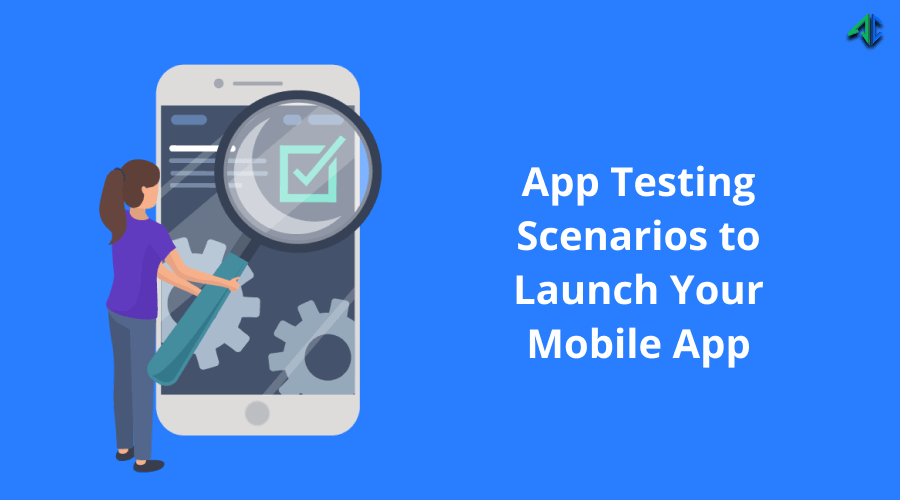Table of Contents
Testing your app before launching it will make sure that you have a bug-free app and prevent any problems from occurring in the future. This blog discusses top app testing scenarios to help you find the bugs, glitches, and errors in your app and make it launch-ready.
Developing a mobile app is not as difficult as it seems, but keeping it up and running is quite an intimidating task. Why? Because if your users encounter any bugs, errors, and glitches while using the app, it will certainly result in app uninstallations. In fact, a study shows that crashes cause 71% of app uninstallations.
Having said that, if you think that you can keep your app error-free without any professional’s help, you are highly mistaken. So give yourself a break and let experts handle the task. That said, you must consider hiring an experienced mobile app testing company that can meticulously test your app and make it launch-ready.
So what app testing scenarios are necessary to ensure that your app is bug-free? Which app testing scenario will help you find the bugs, glitches, and errors in your mobile app? These questions may seem like common sense but are often overlooked by many.
But before you delve deeper to know about different types of app testing scenarios, it’s imperative to learn what exactly mobile app testing scenarios are.
So without any further ado, let’s get right into it!
Mobile App Testing Scenarios: A Quick Introduction
Let’s admit that app testing is a time-consuming process, but at the same time, it’s a vital step in the app development process. Therefore, we must emphasize app testing scenarios to speed up the app testing process.
App testing scenarios allow apps development companies to identify and fix bugs, glitches, and errors that would be difficult for app owners to spot themselves. Mobile app testing scenarios help app testers with app testing in many aspects. Having said that, app testers can use several mobile app testing scenarios for this purpose.
7 Major Types of Mobile App Testing Scenarios to Make Your App Faultless
Documentation Testing Scenarios
Documentation testing is a mobile app testing scenario that mostly focuses on the mobile apps’ documentation part. It’s one of the mobile app testing scenarios that include all mobile application tests cases, such as mobile manual testing, mobile automated testing, and mobile performance testing (mobile QA).
Besides, it includes all system and user manuals developed for mobile devices and mobile applications. It also contains online help files, tutorials, FAQs (Frequently Asked Questions), troubleshooting guides, and other app support documents.
Functional Testing Scenarios
Functional testing is another popular mobile app testing scenario. Since mobile apps involve multi-touchpoints, functional testing focuses on all the possible touchpoints and defines how an app would behave exactly when an end-user interacts with it.
Testing mobile apps for well functioning is more complicated than standard web applications because mobile applications need to work on multiple mobile devices, different mobile operating systems, and in various locations. Hence, functional testing ensures everything works fine.
Usability Testing Scenarios
Before we know about usability testing scenarios, it’s crucial to understand what usability testing is. Well, it is a process to check mobile app features from the point of view of mobile app users who are casual, regular, and active app users.
Usability testing gives valuable insight about mobile apps from users’ perspective, then converting this insight into a plan to improve the mobile app user experience.
Usability testing scenarios help mobile app testers define the tasks of mobile app users that are common to mobile app developers. It provides an idea about how to make the mobile app easy to use for end-users. They find out the ways to improve overall app usability.
Performance Testing Scenarios
It is one of the mobile test scenarios every app tester must perform to gauge the performance, load, and stress of mobile apps. Performance testing ensures that mobile apps run in different network conditions and on all mobile devices flawlessly without any disruption.
Having said that, mobile app performance testing is a pivotal mobile app quality factor that affects mobile users’ satisfaction. Plus, it helps determine the load on the app server and mobile app performance under load conditions.
Compatibility Testing Scenarios
This app testing scenario is used to check mobile app compatibility on different mobile devices. Compatibility testing helps mobile app testers to identify mobile apps that are working fine or not on mobile devices customized with new hardware, software, tools, and features.
This testing method is comparatively quick to other mobile app testing types. It helps in the early detection of any inconsistency found between mobile apps and mobile devices.
Usually, mobile app compatibility testing is executed with the mobile devices that are already used for mobile app functional testing. This type of mobile app compatibility testing can be carried out in both stages: before and after the mobile app development stage.
Security Testing Scenarios
Security testing is an application security testing and mobile app testing practice that aims to identify the security vulnerabilities in mobile applications. It can be done before mobile apps are actually released for use or after mobile apps have been distributed in the market but need some security updates to address newly discovered vulnerabilities.
It’s not just about knowing how many loopholes your mobile app has, but it’s also about knowing how your mobile app treats those weak points. Sometimes mobile apps may have a high risk of frailties that could lead to massive data leakages and security breaches.
Security testing scenario ensures evaluating the mobile application for all the potential security risks, identifies any loophole, insecurity existing in mobile apps, and determines the ways to fix it ASAP.
Recoverability Testing Scenarios
Recovery testing is a mobile app testing type conducted to test mobile applications’ ability to resume the previous state upon interruption or termination. Recoverability testing scenarios ensure that mobile apps function correctly in worst-case scenarios.
Recovery testing for mobile apps can be conducted on mobile simulators or mobile emulators, mobile devices with Android or iOS mobile operating systems.
Recovery testing may be carried out with the help of mobile application software development kits (SDKs), which are provided by developers of mobile applications to test how mobile applications can recover from any unexpected scenarios.
Concluding Thoughts
Before you hit submit on your desired app store, it’s crucial to know if there are any bugs or errors that still need fixing. This is where the best testing scenarios come in handy. That said, we discussed some of the best app testing scenarios to launch your mobile app completely error-free.
These app testing scenarios can help you identify and fix problems with your app, so when users download it, they have an error-free experience from start to finish. We hope with this information at hand, you feel confident launching your new mobile application without fear of rejection due to pesky glitches!
We would love to hear your comments relating to the post. Got some other thoughts? Drop us words through our contact page.








